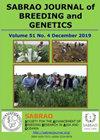性别效应对高原木瓜叶片端粒长度、元素组成和植物化学成分的影响
IF 1.6
Q3 PLANT SCIENCES
引用次数: 0
摘要
高原木瓜是一种雌雄同株、雌雄异株的植物,具有雌性和雄性器官。在印度尼西亚,三种性别的高原木瓜都有不同的端粒长度,可以保护染色体和脱氧核糖核酸(DNA)免受损伤。因此,本研究旨在测定不同性别高原木瓜叶片的端粒长度、元素组成和植物化学成分。在所述叶片(雌性、雄性和雌雄同株)中观察和研究的端粒长度使用聚合酶链式反应(PCR)程序。扫描电子显微镜(SEM)分析提供了更详细的叶片材料,而能量色散X射线(EDX)有助于观察元素组成。通过组织化学分析进行植物化学成分分析。结果表明,雌性、雄性和雌雄同株叶片的端粒长度分别为381、391和396.66。扫描电镜分析表明,三种性别的高原木瓜叶片表面差异不显著。EDX观察表明,钠(1.98%)在雌性植物叶片中出现;然而,钠和氯在雄性植物中没有表现出来。雌雄同株叶片的钠和氯含量分别为0.88%和0.28%。组织化学分析概述了高原木瓜幼叶中黄酮类化合物和单宁的分布。一项发现还指出,这两种化合物都存在于近轴和远轴表皮、叶肉、木质部、韧皮部、鞘薄壁组织、分泌腔和毛状体中。研究得出结论,性别影响高原木瓜叶片的端粒长度、元素组成和植物化学物质含量。研究表明,了解高原木瓜的性别对植物育种和遗传学至关重要,有助于改善植物健康和生产力。本文章由计算机程序翻译,如有差异,请以英文原文为准。
SEX EFFECT ON THE TELOMER LENGTH, ELEMENTAL COMPOSITION, AND PHYTOCHEMICAL CONTENT OF HIGHLAND PAPAYA (VASCONCELLEA PUBESCENS A.DC.) LEAVES
Highland papaya (Vasconcellea pubescens A.DC.) is a monoecious and dioecious plant with female and male organs. In Indonesia, three sexes of highland papaya exist with different telomere lengths, which protect chromosomes and deoxyribonucleic acid (DNA) from damage. Therefore, the purposeful study aimed to determine the telomere length, elemental composition, and phytochemical content of highland papaya leaves belonging to their different sexes. The telomere length observed and studied in said leaves (female, male, and monoecious) used the polymerase chain reaction (PCR) procedure. A scanning electron microscopy (SEM) analysis provided a more detailed material of leaves, while an energy dispersive X-Ray (EDX) helped observe elemental composition. Phytochemical content analysis ran by histochemical analysis. The results showed that the telomere lengths of young female, male, and monoecious leaves differed at 381, 391, and 396.66, respectively. According to the SEM analysis, nonsignificant differences occurred in the leaf surface of the three sexes of highland papaya leaves. Observation with EDX showed that sodium (1.98%) surfaced in female plant leaves; however, sodium and chlorine did not show in male plants. Monoecious leaves had sodium and chlorine at 0.88% and 0.28%, respectively. The histochemical analysis provided an overview of the distribution of flavonoids and tannins in young leaves of highland papaya. A discovery also noted the existence of both compounds in the adaxial and abaxial epidermis, mesophyll, xylem, phloem, sheath parenchyma, secretory cavities, and trichomes. The study concluded that sex affects telomere length, elemental composition, and the phytochemical content of highland papaya leaves. The study suggests that knowing the highland papaya’s sex is vital in plant breeding and genetics and could help improve plant health and productivity.
求助全文
通过发布文献求助,成功后即可免费获取论文全文。
去求助
来源期刊

Sabrao Journal of Breeding and Genetics
农林科学-奶制品与动物科学
CiteScore
1.90
自引率
50.00%
发文量
63
期刊介绍:
The SABRAO Journal of Breeding and Genetics is an international journal of plant breeding and genetics research and was first published in 1969. It is the official publication of the Society for the Advancement of Breeding Research in Asia and Oceania (SABRAO).
Its objectives are to: promote the international exchange of research information on plant breeding and genetics, by describing new research findings, or ideas of a basic or practical nature; and be a medium for the exchange of ideas and news regarding members of the Society.
The Journal gives priority to articles that are of direct relevance to plant breeders and with emphasis on the Asian region. Invited for publication are research articles, short communications, methods, reviews, commentaries, and opinion articles. Scientific contributions are refereed and edited to international standards.
The journal publishes articles for SABRAO members mainly. The Journal preferred strongly that at least one author should be a current member of the Society. Non-members may also publish in the journal.
 求助内容:
求助内容: 应助结果提醒方式:
应助结果提醒方式:


